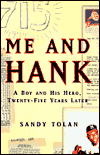Hank Aaron: A heavy hitter
 Sandy Tolan waits until the closing quote in his moving tribute to the great Henry Aaron to admit that it`s not Me and Hank, or even He and Hank.
Sandy Tolan waits until the closing quote in his moving tribute to the great Henry Aaron to admit that it`s not Me and Hank, or even He and Hank. It`s We and Hank.
"Think about all the people Hank motivated," says Dusty Baker, Aaron`s former teammate and current manager of the San Francisco Giants.
"There are tons of us running around that Hank had a direct influence on. Whether he knew it or not."
It happened to me and Sandy at about the same age, seven years apart.
For me, it was 1957, the pinnacle year for the Milwaukee Braves and perhaps Aaron himself.
Aaron was the National League Most Valuable Player that season. I was at the game he calls his biggest in baseball, the night he clinched the National League pennant with an 11th-inning home run.
Aaron was 23 years old. I was 9.
My family had moved to Milwaukee from San Diego that spring. We returned to California in the summer of 1959.
During those two-and-a-half years, Aaron molded my outlook on race.
We lived in a white neighborhood on North 58th Street. A neighbor boy stopped me cold one summer afternoon when I blurted out that I loved Hank Aaron.
"You should," he said. "You look like him."
This was meant as an insult, and I wondered: How can black skin be a bad thing when my hero has black skin?
The answer was pretty simple. It couldn`t.
I followed Aaron and the Braves after we left Milwaukee, and by 1964, the year Sandy Tolan got on board, I was pretty sure Babe Ruth`s career home record was going to fall.
Aaron hit 40 homers, give or take a few, year after year. I just did the math.
What I wasn`t expecting was the well-documented but little-understood nightmare this wonderful chase would be for Aaron.
Tolan does a good job describing how the hate mail and death threats affected the entire Aaron family. Through interviews with the Aarons and black leaders of the time, we understand Aaron`s courage.
His daughter, Gaile, was being shadowed by FBI bodyguards and couldn`t attend the game at Atlanta`s Fulton County Stadium on April 8, 1974, the night Aaron passed Ruth.
I still have the newspaper with the photograph of Aaron`s mother hugging him after he crossed home plate. Gaile Aaron tells Tolan that a cannon had gone off and Mrs. Aaron thought somebody was shooting at her son.
"And she`s holding him like that because she was saying if they`re gonna kill him, we`re gonna go down together."
No wonder Aaron was a bitter man for years. What`s amazing is, he has put most of his anger behind him.
I haven`t. Neither has Sandy Tolan.
But black people Tolan interviews seem to have adjusted to the injustice.
They, of course, are more experienced in such matters.
Tolan unloads on the baseball Hall of Fame for dedicating an entire room to Babe Ruth and only a wall to Aaron. He brings this up to Giants manager Baker.
Baker, who is black, shrugs.
"It`s America, dude," he says. "It`s America."
- Clark Brooks
"Bowling Alone: The Collapse and Revival of American Community" by Robert D. Putnam; Simon & Schuster; 384 pages; $26.
Great title. Great book. Five years ago, in an obscure academic periodical called Journal of Democracy, Harvard professor Robert D. Putnam first suggested that we as a nation are becoming dangerously disengaged from each other.
He saw signs of it everywhere. We vote less often in elections. We give a smaller share of our money to charity. We join fewer clubs and associations.
He was hailed as a prophet in certain quarters, celebrated for speaking what many had been feeling. He even made it into the pantheon of pop culture, People magazine.
But he also drew criticism in academic circles from other scholars who accused him of jumping to conclusions from scant evidence. They said he ignored signs of increased societal connection, such as the Internet.
Now comes Putnam`s fuller treatment of the subject, and if anything, it`s a more convincing indictment.
"For the first two-thirds of the twentieth century a powerful tide bore Americans into ever deeper engagement in the life of their communities, but a few decades ago - silently, without warning - that tide reversed and we were overtaken by a treacherous rip current," Putnam writes in the opening chapter. "Without at first noticing, we have been pulled apart from one another and from our communities over the last third of the century."
The book`s title, "Bowling Alone," comes from the fact that the sport offers a clean window into the broader problem. Bowling is the most popular competitive sport in the nation, more popular than running, golfing, baseball, tennis, soccer, you name it.
But while the number of bowlers has increased by 10 percent in recent years, bowling in leagues has declined 40 percent. Leagues are where people get together to laugh and talk and share. To connect.
If this trend continues, Putnam writes, "league bowling would vanish entirely within the first decade of the new century."
Other parts of our so-called social capital are vanishing, too. Putnam discusses the drop in political participation (we sign 30 percent fewer petitions), in club involvement (a 58 percent drop in meeting attendance), in church-related groups (a membership drop of at least 20 percent).
There`s more. We play fewer card games with each other than we used to. We send fewer greeting cards. We are more likely to ignore highway rules and etiquette. Why has all this happened?
The book examines several causes and says the biggest reason may simply be generational. Younger people now are less likely to read newspapers, attend church, write to their local legislators or attend public meetings.
But a significant reason for our disconnect, Putnam argues, is television. The average American now spends about four hours per day in front of the tube. Our watching has become more habitual and less intentional. We turn it on just to have it on. Half of all Americans, according to surveys, now consider television their primary form of entertainment.
Putnam writes:
"People (who say TV is their prime entertainment) volunteer and work on community projects less often, attend fewer dinner parties and fewer club meetings, spend less time visiting friends, entertain at home less, picnic less, are less interested in politics, give blood less often, write friends less regularly, make fewer long-distance calls, send fewer greeting cards and less e-mail, and express more road rage ...
"Nothing - not low education, not full-time work, not long commutes in urban agglomerations, not poverty or financial distress - is more broadly associated with civic disengagement and social disconnection than is dependence on television for entertainment."
Maybe by now you are saying, "So What?" - that`s the title of one of this book`s sections. And according to Putnam, here`s why: In places where people are connected, where there is community, the schools are better, the neighborhoods are safer and more prosperous, and people are healthier and happier.
This is a controversial, engaging and important book, full of interesting research and thoughtful analysis. It offers some ideas on how to reverse the trend of civic disengagement.
In short, it deserves to be read by anyone who cares about where this country is headed. And therein lies the irony. If Putnam is right about us, we won`t read it.
- John Wilkens
(c) Copley News Service
advertisement

Author: John Wilkens
Archives
Suzanne`s Diary for Nicholas
Hostage
The Final Season - Fathers, Sons and One Last Season in a Classic Ballpark
A Different Drummer
Glory Denied
The Cold Six Thousand
Poker: Bets, Bluffs and Bad Beats
A Primate`s Memoir
Every Handgun Is Aimed At You
Ball Four
The Adversary
They had the `fire` down below
They Were Ours: Gloucester County`s Loss in Vietnam
Morgan`s Run
Exploring the link between biology and behavior
More Articles







